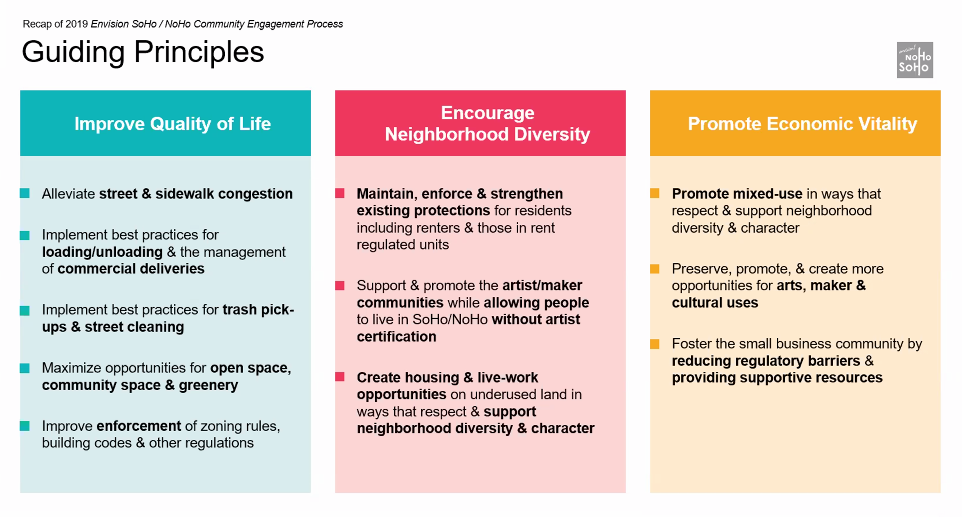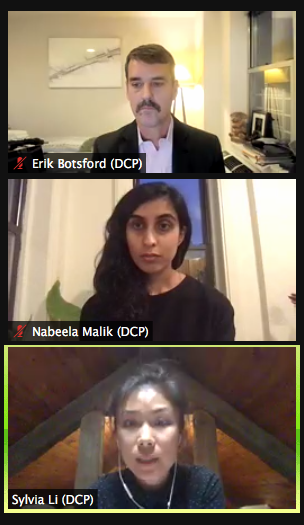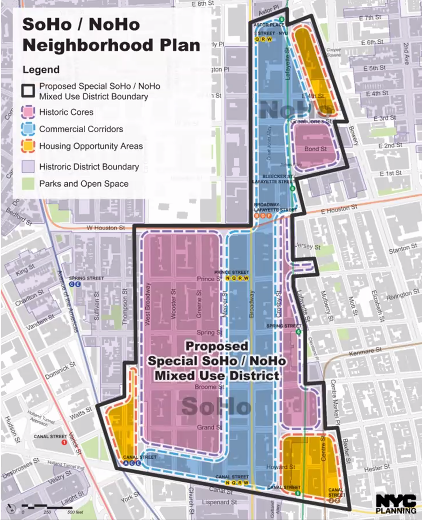BY THE VILLAGE SUN | There weren’t a lot of fireworks at Monday’s meeting about the city’s suddenly revived push to rezone and upzone Soho and Noho. That probably wasn’t surprising, though, given that the meeting was virtual, with audience participation tightly controlled by the Department of City Planning.
State Senator Brad Hoylman did shake things up, though, when he compared the city’s last-minute rezoning rush to the confirmation of the U.S. Supreme Court’s newest justice just one week before the presidential election.
“This is the Amy Coney Barrett of rezoning projects,” Hoylman scoffed. “You have 15 months left and under the climate of COVID… .”
He was referring to how much time Mayor de Blasio has left in office before he is term-limited out of City Hall and how coronavirus has slowed everything down.
Audience questions were carefully curated by City Planning, three members of which led the two-hour affair. (However, the Planning reps said all the questions would, at least, be posted on the agency’s Web site.)
Further limiting the free expression of ideas — at least in real time — the Zoom chat section was switched off, so people could not type their comments for all to see. This certainly squelched what would have been a barrage of angry comments by locals against the plan, which would add both density and a horde of the “ultra-wealthy” to the world-renowned neighborhoods.
During the meeting, audience members learned that the de Blasio administration plans to rezone the two currently manufacturing-zoned Downtown neighborhoods to allow residential construction “as of right”; that means developers would no longer have to go through the currently cumbersome approval process required to construct new apartment buildings in Soho and Noho. In addition, under the plan, the city’s Mandatory Inclusionary Housing program would be implemented for the neighborhoods, meaning 25 percent of the units in all new construction projects would have to be affordable.
The city projects the Soho/Noho rezoning would see a total of up to 3,200 new housing units built in the districts, with 800 of those being affordable but the rest market rate, selling or renting to the highest bidder. That would increase the area’s residential population, which now stands at 7,800, by at least 75 percent, one would imagine.
However, Hoylman slammed the ratio of affordable to market-rate housing in the plan, declaring that it should be significantly higher.
“I think 800 units of affordable housing is a disgrace, a pittance,” he told the meeting.
Hoylman further called the mayor’s Mandatory Inclusionary Housing program a “failure,” charging that it has resulted in construction of 43,000 units of market-rate housing but only 2,000 affordable units.
Adding to the state senator’s skepticism that the Soho/Noho rezoning could be completed in such a short period, he said he still has not even seen a detailed plan of any proposal.

In an interview before the Soho/Noho rezoning meeting, Assemblymember Deborah Glick also blasted both the plan and the process.
“I think everyone is pretty shocked, given the city’s response right after the Soho/Noho envisioning report, which is ‘We’re not doing anything.’ What a lie,” Glick said. “Like so much in this city, it is driven by real estate interests, which promise a lot but end up giving nothing.
“This is why you’re seeing the reaction to a lot of these rezoning proposals — people are catching on,” Glick said, adding, “I think it’s largely a bait and switch.”
Back in January, before the pandemic hit, the mayor had indicated he did not think there was enough time left in his final term — he then had two years left — to rezone Soho and Noho.
A joint initiative of Manhattan Borough President Gale Brewer, Councilmember Margaret Chin and the Department of City Planning, the Envision Soho/Noho process kicked off in January 2019 — albeit to the chagrin of many residents of the famed enclaves who feared it would spur overdevelopment. After nearly a year of community outreach meetings, plus recommendations by a community advisory panel, the process yielded a rather general report in November 2019 that was meant to be fleshed out later into an actual plan. But, with the mayor’s comments earlier this year, the plan was now seemingly off the table — to many residents’ relief.
Fast-forward to this September, though, and the rezoning of Industry City in Sunset Park, Brooklyn, was scuttled after developers pulled out in the face of opposition from Councilmember Carlos Menchaca and Congressmember Nydia Velazaquez, plus lack of support from Council Speaker Corey Johnson. It was the latest high-profile failure of yet another major real estate project for the de Blasio administration. But just mere weeks later, the mayor promptly dusted off the Soho/Noho rezoning proposal and announced it was now back on.
Soho and Noho residents, as well as local politicians and Community Board 2, were all taken off guard at the rezoning’s being resuscitated without any prior notice to them.
Hence, Monday’s meeting, purportedly intended to explain to everyone what exactly is going on at this point.
Sylvia Li, who leads City Planning’s efforts on Manhattan’s West Side, noted that Soho and Noho’s current special zoning dates back to 1971, and was meant to accommodate the artists who were then colonizing its abandoned manufacturing buildings.
“Fast-forward, we’re at a similar juncture,” she said. “The neighborhood has evolved beyond what the zoning allows for.” Li noted there is a “mismatch between the existing zoning and what the zoning allows for.”
In addition, referring to the push for affordable housing in Soho and Noho, she said the new plan would help meet the “demands of our times and our collective values” and “foster a more equitable” neighborhood.
New construction, Li said, would be “maximized” in parts of the proposed area that are not in one of Soho and Noho’s six existing historic districts, which cover 85 percent of the area. There are three of these spots — at the edges of the proposed rezoning — that the city is eyeing for new construction. However, sharp-eyed Soho activists noted the latest map of the proposed rezoning shows that a chunk of one of these three spots that is in Johnson’s Council district — around Broome St. and Sixth Ave. — has been quietly removed from the plan. They assumed this indicates Johnson now wants no part of the contentious initiative.
Nabeela Malik, another of the City Planning presenters, said the “draft scope of work” would be posted on the agency’s Web site this week. This draft will explain what environmental aspects of the project need to be analyzed. There will then be a public meeting on the scoping on Dec. 3.
The project would have to go through the City Environmental Quality Review, or CEQR, which includes an environmental impact study, Malik noted, adding reassuringly, that there are still “many steps” to go in the approval of the rezoning. The last step would be ULURP, the city’s land-use review process, which usually takes about seven months and allows for public review and input at the community board level and during City Council hearings.
Erik Botsford, Planning’s Manhattan deputy director, noted that the city is looking at requiring new construction in Soho and Noho to be contextual, in that it would have to look like the neighborhoods’ traditional high-ceilinged loft spaces, not “tall shiny towers,” as he put it.

The planners alternated between taking questions over Zoom — in which the questioners spoke into their microphone — and written questions that people sent them.
“Why can’t we wait till COVID is over and have real public meetings?” wrote one frustrated audience member in a question that the planners read aloud. “Isn’t the Department of City Planning controlling this [meeting] completely and controlling what questions are asked?”
However, Botsford answered that the Soho/Noho rezoning was critically needed for the city to rebound from the pandemic.
“To not move forward, to wait until there’s a vaccine could really affect the city’s ability to recover,” Botsford maintained.
Other speakers who supported the plan, though, hailed the virtual meeting format, saying it was a great model to use going forward. Some of these individuals appeared to live outside the neighborhood, however.
One speaker who praised the proposal, Casey Berkovitz, is a communications rep for the Century Foundation, a progressive think tank.
“Soho can underwrite deeper levels of affordability,” he said, with a knowing chuckle, implying that the neighborhood’s residents are extremely wealthy.
Several other speakers who work in public affairs were also coincidentally picked to speak at the meeting, including at least one member of Open New York, Kyle Dontoh.
Open New York members typically showed up at the Soho/Noho Envision community meetings to strongly advocate for the city’s rezoning plan. Open New York is dismissed and jeered at by Soho and Noho residents as a front for developers, though the group denies it. Connie Murray, a Long Island City-based writer who blogs as Fuelgrannie, has written a revealing exposé about the group.
Chris Marte, who is running for Lower Manhattan’s City Council District 1, in a spoken question, warned that that “the Soho/Noho rezoning would create displacement potentially on the Lower East Side and Chinatown.”

Botsford called Marte’s point “excellent” and said displacement would be studied as part of the environmental analysis.
The planners lauded Soho and Noho as a “high-opportunity area” since the districts are well served by transportation and near job centers.
A representative of State Senator Brian Kavanagh, noting that many of the area’s office building’s are currently empty due to COVID, asked why they can’t simply be converted to residential use.
However, Botsford answered, “These neighborhoods are vitally important job centers now. We want those uses to continue. … That balance is vitally important.”
Speaking afterward, Pete Davies, of the Broadway Residents Committee, who is a member of the rezoning advisory group, said the process is clearly being rushed now.
“The Department of City Planning reps as much as admitted tonight that they have not done any of the necessary work outlined in the final pages of the November 2019 Recommendations… (‘Next Steps and areas for additional study and analysis’).
“So Planning can hardly be ready to move forward, as they are scrambling to do now. But what choice do they have when given orders by de Mayor (who must be desperate for numbers to fill his measly MIH column, after losing so badly at Industry City, and seeing a year of lame-duckness looming before him)? It will be interesting to see if anyone wants to stand by him on this — or anything else — as his final year closes in on him.
“Senator Hoylman said it best when he pointed to the failure of de Mayor’s MIH schemes,” Davies added. “Market-driven investor (donor?) games, which (if ever built) would result in an even greater divide than there is now? Is that the best we can do?”
Sean Sweeney, director of the Soho Alliance, decried the virtual meeting a “farce.”
“It was like Big Brother on a giant TV screen and the rest of us proles invisible,” he said, indignantly. “The sponsors decided whose questions to answer and which to dodge.
“For instance, they ignored my question, the most obvious one: Since Mandatory Inclusionary Housing was never mentioned once during last year’s Envision Soho/Noho meetings, why all of a sudden is it the main focus now?
“Zoom meetings remove energy and the hands-on experience that an in-person meeting provides,” Sweeney charged. “Notice that the people who like the Zoom meetings were those who are not from Soho. In other words, they could influence what happens in our neighborhood from the comfort of their armchairs in Brooklyn.
“On the other hand, it was the locals who want real, spontaneous and true public meetings,” the Soho activist said. “A Zoom meeting is not a public meeting.
“It’s like de Blasio has taken advantage of COVID in order to dilute the energy of the community and to shape and control 100 percent the outcome of this process.”
Andrew Berman, director of Village Preservation, also voiced concerns about the rezoning plan in comments during the meeting. Afterward, he gave a statement to The Village Sun.
“There is a frustrating lack of detail provided so far, but there are enough indications to cause serious concern,” he told the paper. “We know the city wants to upzone a substantial portion of the neighborhood, which would result in even larger development than the 60-plus buildings already constructed in these two small neighborhoods in the last several years.
“We know they want to make it easier for big-box chain retail stores to locate here, too, while small independent businesses are suffering unprecedented hardships.
“The one positive indication,” Berman said, “was the potential application of contextual zoning — but without any details about what height limits would be included, that’s a meaningless announcement.
“We noticed that the proposed rezoning area has also been rolled back slightly on the west side, which is good. But we also know that big real estate interests have been behind this push and this process, and that major donors to the mayor’s campaign and now-shuttered nonprofit, like Edison Properties, are being rewarded with upzonings for their development sites.
“The city promised that there would be no movement on this process without engaging the community advisory board,” Berman added. “In fact, the board hasn’t met in nearly a year, and the city just sprung this October surprise upon all of us. There was great distrust of this process from the beginning; it seems those fears were well-founded.”


[…] expected to stick to strict, timer-enforced time limits and unable to interject at their pleasure, were in some way being censored, now that their God-granted right to jeer and harangue anyone who disagreed with them had been […]
I hope the Dept. of City Planning ignores the millionaire crybaby NIMBYs in SoHo. This city has a massive housing shortage. This city has an immense housing shortage. There is no better place to build lots of housing than a rich white neighborhood near lots of transit located between two of the biggest job centers in the Western Hemisphere.
Sean Sweeney whining about Zoom public meetings is the height of white privilege. He wants to intimidate and bully any pro-housing supporter.
Brad Hoylman should be ashamed of himself. The situations are in no way analogous and comparing the Dept. of City Planning to Senate Republicans is incredibly shameful.
Because he lacks sound arguments to support his tenuous opinions, Heckwolf constantly and childishly throws ad hominem attacks at his opponents, Ridiculous ad hominems like “white privilege” and “SoHo millionaires” and “rich white neighborhoods.”
But let’s not talk opinions or ad hominems; let’s talk facts.
Heckwolf is a recent California transplant to – guess where? – gentrified Fort Greene in Brooklyn. How many poor people of color did he help displace?
He came from Republican Orange County in the upscale bedroom community of Laguna Niguel. Laguna Niguel has a median household income 31 percent above the Orange County average and nearly DOUBLE the U.S. average. Its median family income is well over $150,000.
Its racial makeup is – are you ready? – 84% white and 1.25 % black.
It looks like Heckwolf’s animosity against working-class New Yorkers who pioneered the urban wilderness of SoHo/NoHo while he frolicked in the California sun might be the reason he needs to expiate the white guilt of his privileged upbringing.
Nothing better than outing a hypocrite. Well done Sean.
Another excellent, well-written and comprehensive article of a neighborhood issue by The Village Sun. . . . One question: What constitutes “affordable housing”? Some of the City’s advertisements in newspapers offering affordable housing indicate a minimum income of $38,000 a year.
Yes, Alan, some “affordable housing” requires a minimum income of $38,000, eliminating all those needy New Yorkers who earn minimum wage.
However, most “affordable” schemes gravitate even more toward the upper spectrum of income.
For example, one project in Hell’s Kitchen requires a MINIMUM of $68,500 income for a mere studio. Another in Long Island City provides a 3-bedroom residence for $5,500 a month to those earning as much as $269,000 – over a quarter of a million dollars annually!!
What should be a program for the needy and working class, under de Blasio has become a gold mine for developers and a subsidy for the wealthy.
After nearly a year of frustrating community outreach meetings, plus vague recommendations by a community advisory panel, the process was basically nonresponsive to community concerns. Why is the city not engaging with residents? Why does the city want to put luxury skyscrapers in the community? Why can’t new housing be 100% affordable and in scale? What protection will existing tenants in SoHo, NoHo and Chinatown have against real estate speculation and displacement? Why is the city helping big chains to proliferate here, when its small independent businesses are experiencing unprecedented pain and challenges right now? We know big property owners and developers pushed for this rezoning: Will the city release a list of all the developers and real estate interests who lobbied for this rezoning, and who donated to the mayor’s campaign and his now-defunct Campaign for One New York? This plan is a disaster in the making.
De Blasio and his real estate cronies, all about his friends that own the empty parking lots. And wow that is a revealing expose of the real estate investor-fueled astroturf Open NY front.